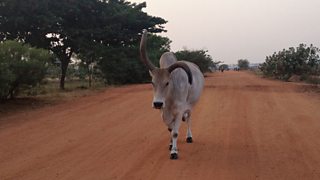At 主播大秀 Media Action鈥檚 office in Juba, South Sudan, we're more used to talking about colostrum, not cattle. But while making one of our recent programmes about maternal and child health, we found ourselves discussing cows and calves, goats and kids - just not of the human kind.听
I'll first explain how we got to such a surprising position. We're currently making radio programmes that address some of the reasons behind the dreadful fact that a 15-year-old girl in South Sudan has a greater chance of dying in childbirth than of finishing school. Our weekly magazine programme Our Tukul and radio drama Life In Lulu look at what people can do to stop so many mothers and babies from dying in a country where there are less than 100 qualified midwives.听
Audience research
Our programmes address a complex mesh of social and cultural beliefs and we realised early on that audience research was going to be absolutely crucial. We spent a lot of time sitting down with production and research teams trying to digest what South Sudanese audiences knew and believed about mother and child health - particularly men and older women who influence most of the health decisions made within a family.听
One important finding was that colostrum - the first, highly nutritious milk from the mother鈥檚 breast - is considered dirty and often thrown away. To complicate things further, women also believe that feeding a new baby breast milk alone is inadequate and that a baby should also be fed water and food, something which can be harmful in the first six months.听
The challenge for the Our Tukul team was persuading the audience to think differently about practices that have been common for generations. That's when they came up with the idea of referring to goats and cows who do feed their young their first milk and that this helps them grow into healthy kids and calves.

Animals are an important part of South Sudanese life and the team figured out they could use what people already know about keeping animals healthy to show how to keep babies healthy too.
The results were better than I could have expected.
We recorded a fantastic interview from Rumbek, which is in the centre of South Sudan and one of the main cattle rearing parts of the country. The interviewee, a seasoned cattle-farmer, clearly explained how the first milk helped the calves in his herd. He even said that if a calf dies soon after birth, the mother's milk is given to another calf to take advantage of its high nutritional value.
The interview really resonated with our listeners. In the city of Wau, in the north west of the country, local midwife Monica Ilario visited our partner radio station Voice of Hope to congratulate them on the programme.
It turns out that Ilario had been thinking similarly herself. "She gave us a copy of a research paper she had written on breastfeeding where she also compared animal and human breastfeeding behaviour," says Enrica Valenti, the station director.
Looking ahead
Our work is far from done – Our Tukul has only been on air for a few months – but it's great to see such early evidence of the audience engaging with the show.
We're now thinking about different ways to talk about time with a non-numerate audience. This is so we can talk about the health benefits of child spacing. For example, we're exploring how the concept of leaving two years between the birth of one child and trying for another can be expressed in terms of harvests, seasons or big events like Independence Day.
We'll keep going to back to our audience throughout this project, finding out what they think and why. Only by thinking like our audience can we make sure our programmes convey their life-saving information and help women giving birth in South Sudan to become more than a terrible statistic.
Related links
